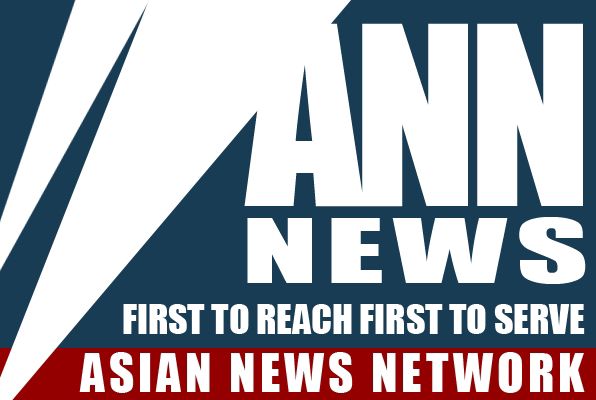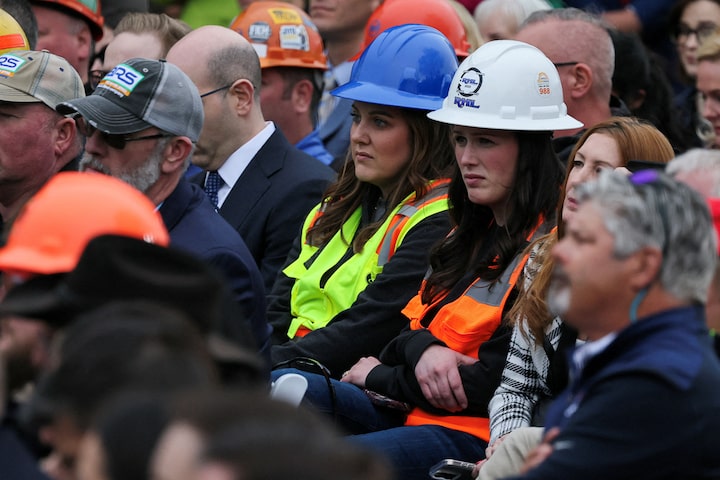Workers wear safety helmets as they listen to U.S. President Donald Trump (not pictured) deliver remarks on tariffs, in the Rose Garden at the White House in Washington, D.C., U.S., April 2, 2025. REUTERS
Summary
- Nonfarm payrolls forecast to increase by 135,000 in March
- DOGE firings to accelerate federal government job losses
- The unemployment rate expected to hold steady at 4.1%
- Average hourly earnings seen rising 0.3%; up 3.9% y/y
WASHINGTON, April 4 (Reuters) – U.S. job growth likely slowed in March amid mass firings of public sector workers to slash federal government spending and reluctance by businesses to increase hiring because of import tariffs that have put the economy’s health in peril.
The labor market’s fortunes will likely continue fading after President Donald Trump unveiled a 10% minimum tariff on most goods imported into the U.S. on Wednesday, unleashing threats of retaliation and rattling global financial markets.
Economists estimated that Trump’s sweeping import duties had boosted the nation’s effective tariff rate to the highest level in more than a century and warned of layoffs as businesses and consumers pull back on spending. Since returning to the White House, Trump’s tariffs blitz had already unnerved businesses, which had cheered his electoral victory in November.
Economists said businesses likely finalized their spending plans for 2025 at the end of last year, but were now scrambling to reset, possibly forcing many to take a more conservative approach to adding headcount.
“We have gone from an economy that was doing very well to really a situation that is chaotic,” said Brian Bethune, an economics professor at Boston College. “It’s not a good environment for businesses, it’s a nightmare.”
The Labor Department’s closely watched employment report on Friday is expected to show nonfarm payrolls increasing by 135,000 jobs last month after rising 151,000 in February, a Reuters survey of economists showed. That would be well below the 190,000 monthly average over the past six months, but just enough to keep up with growth in the working-age population.
The unemployment rate is forecast steady at 4.1%. Payrolls growth estimates ranged from 50,000 to 185,000, reflecting both downside and upside risks to the forecast. Federal government payrolls likely declined by as many as 25,000 jobs last month.
DOGE PUZZLE
Tech billionaire Elon Musk’s Department of Government Efficiency, or DOGE, has taken a chainsaw to the public workforce as part of a radical campaign by the Trump administration to cut spending and downsize the government.
But courts have ordered the reinstatement of thousands of workers, while some have been put on administrative leave and others have opted for deferred resignations, making it difficult to track the job cuts.
Payrolls growth could also exceed expectations in March as part of the slowdown in January was because of freezing temperatures. Cold conditions persisted in February, which limited the anticipated rebound. At least 14,800 striking nurses and supermarket workers returned to work in late February and would be included in March’s payrolls count.
Economists said the effects of the reciprocal tariffs could be evident as soon as with April’s employment report. Retail payrolls are most likely to decline as consumers hunker down amid price increases while the impact for manufacturing could ramp up over time.
“While we do not expect broad-based layoffs, we foresee the unemployment rate rising above 4.5% in 2025 in coming quarters as labor market conditions deteriorate and hiring decelerates further,” said Lydia Boussour, senior economist at EY-Parthenon.
Business activity accelerated at the start of the year as companies rushed to complete work orders and bring in imports before the tariffs kicked in, sharply widening the trade deficit. Consumers also engaged in pre-emptive buying of goods at the end of 2024, but pulled back in January.
Gross domestic product growth estimates for the first quarter are below a 0.5% annualized rate, with high odds of a contraction. Economists are not ruling out a recession in the next 12 months.
They also expect inflation and the unemployment rate to rise. Faced with a weakening economy and rising joblessness, economists say the Federal Reserve would have no choice but to cut interest rates even if inflation remains high.
U.S. central bank officials in projections released at their March policy meeting forecast two interest rate cuts this year. Financial markets expect the Fed to resume easing policy after pausing in January. The central bank’s policy rate is currently in the 4.25%-4.50% range.
“We should not be surprised if maybe next year, the net result of this tariff policy is more cuts than we expect, but I think it’ll be a messy process for the Fed to get there,” said Ernie Tedeschi, director of economics at the Budget Lab at Yale.
“In the meantime, the Fed is going to be very cautious about moving either way on rates. It’s very concerned about inflation reaccelerating, and it knows that tariffs are going to put upward pressure on prices, so they want to be very careful.”
Reporting by Lucia Mutikani; Editing by Andrea Ricci





